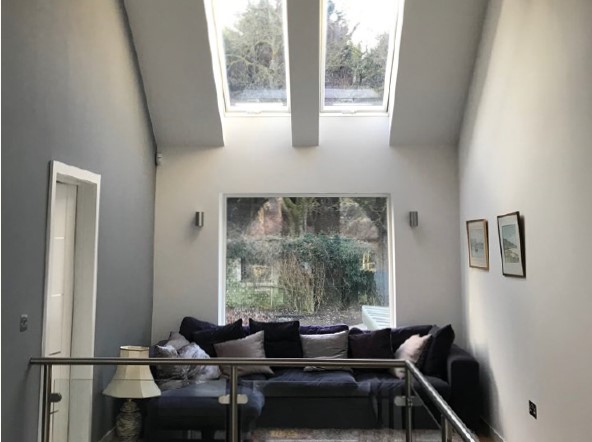New Dwelling House at Grange View

|
| The New Dwelling House at Grange View was awarded the Alan King Award for Excellence in Architectural Technology at CIAT’s AT Awards in 2019. |
Contents |
[edit] Outline
The client’s brief was to create a contemporary, low-energy, accessible dwelling within a former walled garden, to nestle into the existing streetscape. Due to the limited mobility of the client, the dwelling had to be designed to allow for full accessibility without being obvious, as the site is surrounded on three sides with mature trees and a public road to the fourth – the use and deflection of light was paramount.
The site required to have two primary elevations with the formal public elevation designed to reflect the Victorian gabled frontage of the surrounding properties, using modern materials to put a subtle twist on the design. The ground floor has been designed to form a free-flowing family space, allowing each area to retain its own identity but remove access barriers which would be an issue to the client’s mobility. The southerly garden-facing elevations were designed to allow for maximum solar gains deflecting into other areas of the dwelling and forming features inside with a fully vaulted entrance hallway.
Surrounded with historic lime trees among 30-plus protected trees on site, particular care had to be taken to protect and preserve these at design stage ensuring they were not compromised now and in the future – this gave the benefit of the dwelling being set into an already mature setting. The property was designed with a limited frame structure, which allowed for continual bulk deliveries, as the site is located on a busy thoroughfare.
Disruption was kept to a minimum with planned deliveries and installations carried out at specific times. The site is adjacent to an anterior route as it is located within a former walled garden along with 30-plus TPO trees. This meant that material delivery and movement were restricted and had to be managed carefully, along with the main contractor, to ensure that storage areas were maintained, as well as site access routes controlled and safely managed.
Pre-planning at design stage was carried out to reduce impacts on public traffic flows. Deliveries were timetabled to non-peak times, as well as sub-soil removals being carried out at the same time as a large-scale services road closure. This allowed controlled removal to an adjoining site for landscaping works, ensuring the impact on landfill was reduced.
The overall structure was carefully planned with a main steel frame to the central core interacting with a timber structure infill to allow reduced and simplified movement on site. The building was specifically designed for our clients who have progressive mobility issues: we created large, flowing open-plan areas divided by specifically-located partitions or doors which are DDA compliant. The structure around the feature stair was formed to be able to support any future chairlifts and the first floor pre-trimmed for a possible future lift.
The large ‘living hub’ area, sub divided by lowered feature ceiling area, ensures that the mechanical ventilation with heat recovery (MVHR) system is not compromised and controls airflow and optimum ventilation without structured barriers. The central ‘hub’ was designed as the central living space with positioning and balancing expanses of glazing to the area at high level with overhanging sections to lower levels. This ensured that maximum light was afforded along with controlling solar gains; also, the addition of a contemporary multi-fuel stove within the ‘snug’ section, with careful positioning of thermostats, allowed the control of the heating system with primary and secondary demands. The large vaulted nature of the structure at this point with the MVHR ensured that all heat was carefully re-distributed and controlled.
The master bedroom located directly off the ‘hub’ area benefits from a feature vaulted ceiling and direct access to the garden terrace. To ensure energy use was reduced to a minimum for now and the future, the dwelling was over insulated by 25%.
The overall sustainability and lifetime worth of all elements were fittingly considered through the design process. Each material was scored to ensure its benefits outweighed any negatives in relation to a number of factors. This included embodied energy, production values and transport, with the overall aim to construct and finish the property with long-term durable materials. The property was designed and post tested with an airtightness level of four, which was pre-consulted to reach optimum performance, as well as suit the client’s living style. This was formed with high performance variable vapour barriers and specific taping, with challenging junctions designed out to simplify site taping.
The addition of a PV solar array to the southerly-facing roof designed to supplement main demand, and large rooflights and expanses of specifically-positioned glazing to sheltered areas, means that the demand on artificial lighting is significantly reduced.
[edit] Judges’ comments
This new dwelling is an excellently laid-out scheme with exact brief design and the aspiration of lifetime home standards — it is flexible enough for anyone to use it. There is a fine attention to detail and thoroughly thought through to address the user’s needs now and in the future. Within the design, the maximum use of solar gain has been utilised without overheating. This is a showcase for demonstrating how technology has supported the design, making it an outstanding winner for the Alan King Award.
[edit] About this article
This article was written by Stuart Davidson Architecture for CIAT’s AT Journal (No 131, Autumn 2019). It can be accessed HERE.
Other articles by the CIAT on Designing Buildings Wiki can be accessed HERE.
[edit] Related articles on Designing Buildings Wiki
- A Home to Remember.
- Accessibility in the built environment.
- Access audit.
- Access consultant.
- Access and inclusion in the built environment: policy and guidance.
- Accessible London.
- Anthropometrics in architectural design.
- Approved document M.
- Balance for Better: Why lack of diversity is an issue for everyone.
- Built Environment Professional Education BEPE.
- Changing lifestyles.
- Equality Act.
- Equal opportunities policy.
- Essential principles, Creating an accessible and inclusive environment.
- Evacuating vulnerable and dependent people from buildings in an emergency FB 52.
- Guide Dogs' Inclusivity campaign.
- Inclusive design.
- Lifetime homes.
- Lifetime neighbourhoods.
- Older people.
- National Planning Policy Framework.
- Planning permission.
- Ramps.
- Special educational needs: an analysis of the necessities for inclusion
- Stairlift.
--CIAT
Featured articles and news
The UK's Modern Industrial Strategy: A 10 year plan
Previous consultation criticism, current key elements and general support with some persisting reservations.
Building Safety Regulator reforms
New roles, new staff and a new fast track service pave the way for a single construction regulator.
Architectural Technologist CPDs and Communications
CIAT CPD… and how you can do it!
Cooling centres and cool spaces
Managing extreme heat in cities by directing the public to places for heat stress relief and water sources.
Winter gardens: A brief history and warm variations
Extending the season with glass in different forms and terms.
Restoring Great Yarmouth's Winter Gardens
Transforming one of the least sustainable constructions imaginable.
Construction Skills Mission Board launch sector drive
Newly formed government and industry collaboration set strategy for recruiting an additional 100,000 construction workers a year.
New Architects Code comes into effect in September 2025
ARB Architects Code of Conduct and Practice available with ongoing consultation regarding guidance.
Welsh Skills Body (Medr) launches ambitious plan
The new skills body brings together funding and regulation of tertiary education and research for the devolved nation.
Paul Gandy FCIOB announced as next CIOB President
Former Tilbury Douglas CEO takes helm.
UK Infrastructure: A 10 Year Strategy. In brief with reactions
With the National Infrastructure and Service Transformation Authority (NISTA).
Ebenezer Howard: inventor of the garden city. Book review.
The Grenfell Tower fire, eight years on
A time to pause and reflect as Dubai tower block fire reported just before anniversary.
Airtightness Topic Guide BSRIA TG 27/2025
Explaining the basics of airtightness, what it is, why it's important, when it's required and how it's carried out.
Construction contract awards hit lowest point of 2025
Plummeting for second consecutive month, intensifying concerns for housing and infrastructure goals.
Understanding Mental Health in the Built Environment 2025
Examining the state of mental health in construction, shedding light on levels of stress, anxiety and depression.






















